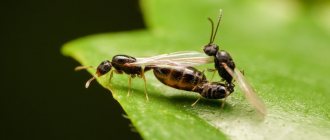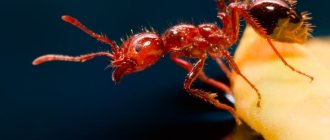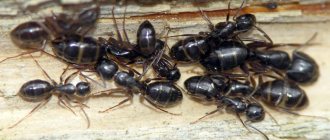A living organism needs rest and sleep. However, looking at the vigorous activity of ants, we can draw conclusions that life in the anthill is in full swing during daylight hours and is unlikely to stop at night.
Ants never sleep in the full sense of the word , but to restore strength and replenish energy resources, these tiny insects can freeze for a couple of minutes several times throughout the day.
This dream can be repeated up to hundreds of times a day. The ability of ants to restore energy reserves with the help of short-term sleep is called a kind of guarantor of protection for the anthill, since most of the colony is always awake.
Do ants sleep
In order to find out whether ants sleep at all, researchers of the insect world placed tiny cameras inside the anthill passages, which monitored the lives of workers of the insect world around the clock.
After some time, recordings obtained through video cameras placed in the colony allowed us to conclude that the ants sleep for short periods of time.
During the day, ants sleep up to two hundred to two hundred and fifty times a day . In this case, the duration of sleep does not exceed one to two minutes. During the specified time, the insect freezes, after which it continues the previously interrupted activity.
The duration of sleep is no more than five hours for workers, soldiers and other inhabitants of the home. However, the queen or queen may nap for eight hours or more.
Ants - description
Very well organized and socially developed insects, the distribution of work occurs depending on the individual.
Ants are insects that mostly live in colonies, divided into castes of three types:
- female individuals with wings and sexually mature after fertilization can leave the anthill;
- males are intended to impregnate the queen;
- and ants are workers, they are responsible for obtaining food, caring for larvae, etc.
The structure of their bodies consists of three parts: the head and the thoracic region, connected to the abdomen by a thin waist, covered with a chitinous shell.
They can reach from one to three centimeters in length. Also, nature has endowed them with eyes consisting of a huge number of lenses and they do not record images, but mainly only movement; on the bug’s head there are antennae that serve as an organ of touch.
Let's celebrate! The color of this insect varies: black, red, green, etc. Reproduction occurs once a year, after which the fertilized females leave the common anthill in order to create their own colony, while the males die.
Do ants sleep or not?
The question of whether ants sleep has interested many scientists. Previously, it was believed that the insect does not sleep at all, and after research it was discovered that ants do sleep. Of course, their sleep is not long and amounts to about four hours per day.
An ant sleeps for about two minutes at a time; over the course of 24 hours, it falls asleep about a hundred times and only for two minutes.
Good to know! The queen ant also sleeps, but during the day the duration of sleep is an order of magnitude longer and amounts to eight hours. In winter, if the colony lives in the north, the insects fall into suspended animation, which can last up to nine months.
What and how often do they eat?
Ants are insects that eat whatever they find. Food can be of plant or animal origin.
They drag the collected prey into the anthill house, and then it is distributed among its inhabitants:
- larvae - for their full and rapid development, they need protein food of animal origin; they feed on the eggs of others and the corpses of other insects. But not all larvae can feed on their own; for this purpose, there are goosebumps that feed them with food semi-digested by their own body, by regurgitation;
- mature adults of this family prefer to eat light carbohydrate foods, which can be fruits, vegetables, nuts, etc.
- queen - her diet also includes proteins; in most cases, her food is chewed by the individuals caring for her.
The ant feeds several times during the day. Those that collect food absorb part of it in the process of delivering it to the anthill. Those that do not leave the anthill are constantly fed by accumulated food reserves.
Good to know! Cold winters in some regions force ants to fall into so-called hibernation, during which they do not feed on anything, maintaining life through the fluid accumulated in the abdomen.
What does the queen ant look like?
There are from one to two queens (queens) in an ant colony; their number is affected by the size of the settlement.
Externally it differs:
- in size - the ant queen (queen) is much larger than other individuals;
- mobility - despite the size, less prone to movement;
- the shape of the abdomen is more round, and its color is darker;
- It is also noticeable that the thoracic section of the uterus is larger than the head; in other individuals the size is proportional to the head.
Note! The queen ant has wings. Having become a sexually mature individual after fertilization, it leaves the common anthill to create its own colony. Having found a place for itself, it chews off its wings and later you can see the scars in their place.
How do ants winter?
The life activity of ant colonies in winter directly depends on the temperature regime established for the winter period in the region of their habitat. But they always conscientiously prepare for the winter, accumulating food reserves and preparing the anthill for the cold.
Before the start of winter, ants prepare food reserves (seeds, dried plants, etc.) and store them in special storage areas of the anthill. With the onset of cold weather, the entrances to the anthill are closed with various dry twigs and earth.
Note! The insects themselves descend to a lower level into tunnels located underground.
Their life activity continues, but inside the anthill. If insects live in places where winters are very cold, then they hibernate for the entire period.
How do they sleep
Since ants sleep for a minimal period of time, but many times a day, sleep can find a representative of the colony anywhere. While resting, ants tilt their heads and lower their antennae. After a few seconds, the individual wakes up, comes to its senses, and then continues its hike.
Queens or queens sleep in a similar manner. However, the video obtained after conducting round-the-clock monitoring of the life of the colony recorded a peculiarity: if the queen sleeps with her head slightly raised, this indicates shallow sleep. If she sleeps with her antennae and head down, then we are talking about deep sleep, which lasts longer than usual.
How long do they sleep?
How much an ant sleeps depends on the caste of a particular individual. For example, the duration of sleep of the uterus is comparable to the amount of rest needed by the average person, and is about eight hours a day. The remaining representatives of the colony, that is, workers, soldiers, nannies and others, sleep somewhat less - the total sleep duration of such individuals is eight hours.
During the winter period , ants living in areas with moderate or severe climatic conditions can fall into a state of suspended animation, which can also be characterized as prolonged sleep.
As a rule, this is typical only for certain species; some of them spend the winter in a state of half-sleep, when their activity decreases, but does not stop.
The fact that such freezing of individual individuals is precisely a dream is also evidenced by the following: if a sleeping ant is touched by relatives running past, there is no response from this individual. The following can also happen: when a threat arises to the anthill, relatives wake up the sleeping individuals, informing them of the need to protect the colony.
Interesting facts about ants
Many people wonder why ants never sleep, even at night. There is only one answer - protecting your own home and colony. Let's find out a little more interesting facts about such hardworking insects.
The presented insects are an amazing species, which is distinguished by unique behavioral characteristics.
The following facts are worth noting:
- Regardless of which caste an individual belongs to, it is characterized by sufficient intelligence. Ants that live in difficult labyrinthine conditions will go in the right direction and find a way out much faster than other types of insects,
- Ants are considered to be the most ancient representatives of the insect world that live on Earth without changes in appearance. Scientists have found fossils of industrious workers 100 million years old
- This is an omnivorous insect that can not only consume organic matter (for example, rotted roots of vegetation and fallen leaves) for food, but also attack in groups other species of arthropods,
- The strength of one adult individual is sufficient to lift a load that exceeds the weight of its own body,
- Ants are very caring, this is manifested by the fact that they feed their relatives who cannot obtain food, for example, due to injury or illness. This continues until the mutilated individuals begin to tap their antennae on their heads - this gives a conditioned signal about their recovery,
- Insects can execute each other if the worker soldier, whose duty is to obtain food, returns several times without food to the anthill. When this is repeated, the individual itself turns into food for its relatives,
- In tropical countries, a species of predatory ant is widespread, destroying in a group everything that is encountered along the way - regardless of whether it is a plant or an animal. Even lions and other species of mammals do not want to meet these arthropods,
- For an ant, aphids are a kind of “livestock”; the workers of the family take care of them, and as gratitude they receive sweet enzymes rich in nutrients.
- Some of the representatives of the colony are peculiar drones, although many believe that they all perform the same workload. It has been studied that 80 percent of the inhabitants of an anthill arrange housing, protect it, and get food, while the remaining 20 are lazy. But it is worth noting that if the number of hard workers decreases, there will be no noticeable changes; why this is so is still a mystery to everyone.
So, let's conclude: the tiny hard workers are awake most of the time, and they devote a minimal period to sleep. For them, only short-term superficial rest is important, thanks to which they restore their own performance and replenish the body’s energy reserves.
When ants sleep
Ants sleep at any time of the day. Despite the fact that at night the anthill’s connection with the outside world is interrupted until morning, which implies the closing of the passages, life continues to boil directly inside the colony. As for sleep during the cold season, individuals that hibernate are in a state of suspended animation until the weather warms up and the snow melts.
Scientists have identified a peculiarity : the body of ants in a state of hibernation continues to function, but in a slow motion.
In this way, insects conserve the body’s energy resources, which allows them to consume less food than usual. In part, it is this specificity of life activity that allows the colony to survive a period of prolonged cold weather.
How long do ants live
Almost all varieties have the same stages of ant development, and the diagram looks familiar. Some individuals differ in their lifespan; this largely determines the lifespan of one anthill and the likelihood of its further development. One of the main criteria is the duration of existence; let’s consider this indicator using the example of pharaoh ants. Research has shown that the more benefits an ant brings, the longer its lifespan, but if it has a one-time role, then there is no point in its existence after completing its mission. Let's look at the life expectancy indicators for each member of the colony in more detail:
- Uterus. This individual is the most important in the anthill; without her, nothing would have happened and nothing will happen. For this reason, even some animals can envy its life expectancy, since in the wild this figure is 15-17 years, and in captivity some representatives lived up to 20 years, which may not be impressive.
- Workers. They represent the main labor force, these individuals supply food to the colony, clean it from dirt, and if the need arises, they defend the weaker inhabitants. On average, their life expectancy is 3-5 years, and in the laboratory this figure increases to 6-7 years. Such a serious difference between the laboratory and natural conditions is due to the fact that the latter environment has a large number of enemies and negative environmental conditions.
- Males. As a joke, experts may call these individuals inseminators, and this is absolutely true. They have one single purpose - fertilization of the uterus. Males do not work at all, do not look for food, but do not cause harm. Such an ant performs its function several times during its life and then dies. The entire life of this “lucky guy” lasts 14-21 days. Even in laboratory conditions, the lifespan remains at this level, since if the individual does not die a natural death, then it is killed by workers.
If for some reason the death of the queen occurs, then there will be no reason for everyone else to exist. Some individuals will go in search of a better life, while the rest will die from melancholy and hunger.
Ants are highly organized and social insects, which in the process of their development have reached an excellent level, which is manifested not only in their relationship with their relatives, but also in their external structure and characteristic stages of development. There are many varieties of ants, but they are all united by the presence of common characteristics and aspects. When you look at some of them, you can’t help but be surprised at how amazing these insects are. The stages of development of ants are realized according to a pattern characteristic of all species.
Do they sleep at night?
So, the life of an ant colony is in full swing around the clock; at night, individual representatives do not sleep, protecting the anthill and caring for the larvae. It is especially important to protect the colony from various external factors, for example, enemies, natural disasters - floods, fires.
When a threat appears, adults exhibit an immediate reaction, which may differ according to caste. For example, nurse ants strive to immediately move the queen and larvae to a safe place, soldiers prevent an attack on the colony of other insects.
The absence of night rest allows the colony to prevent attacks from other insects and mammals that hunt during this time of day.
The queen or queen also sleeps throughout the day; scientists have not identified the dependence of the duration of her sleep on the period of the day. However, during the cold season, the queens of most ant species sleep - they fall into a state of suspended animation, do not lay eggs, and their food and energy needs are significantly reduced.
What do ants eat in nature?
Most ant species base their daily diet on both simple plant and animal products. These insects drag into their home almost everything edible that comes their way. Food is stored in the anthill, after which it is divided among the individuals inhabiting the colony.
The larvae get protein food. This includes the eggs of other insects, the remains of beetles, caterpillars, and small animals. Eating such food promotes the rapid development of larvae and their transformation into adults.
Sexually mature, formed ants absorb carbohydrate, easily digestible food. They give preference to all kinds of seeds, fruit pulp, tree sap, and honey.
There are predator ants. A striking example is the species of Cerapachis. The latter drag only the remains of insects into the colony. Sometimes they do not disdain carrion in the form of half-decomposed animal bodies.
The main source of carbohydrates for carpenter ants is the so-called gum. The substance is a tree resin that is released from trunks in areas where the bark is damaged.
Harvester ants choose solid and rough plant food as the basis of their carbohydrate diet. The individuals, known in the colony as soldiers, spend the bulk of the day grinding all sorts of seeds with their powerful jaws. The result is the production of a specific pulp. The entire colony feeds last.











